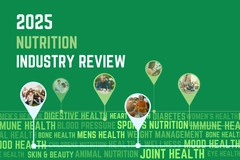EU updates HMO marketing regulations while research spotlights its potential in boosting child growth

20 Feb 2020 --- Industry spotlights human milk oligosaccharides (HMOs) on labels due to their beneficial health properties, but an impending EU Regulation is to set stricter marketing requirements. The move seeks to assure that advertising does not overexaggerate nutrient claims or mislead consumers. The news comes as a new study conducted at the University of California – San Diego, US, showed that HMOs found in breast milk may influence a child’s growth from infancy through early childhood, while maternal obesity may affect HMO composition in breast milk. The study emphasizes the central role and abundant opportunities HMOs hold not only for the infant formula sector but for nutrition in general.
Upon receiving clinical data supporting their products’ functional nutrition profile, baby formula companies are often more than eager to promote the health benefits of their products on formula labeling. However, lenient and even false advertising in the EU baby formula sector has led to the EU Commission (EC) to introduce a new Regulation that restricts formulas’ advertising and marketing. By forbidding the print of health and nutrition claims on infant formula, the Regulation aims to streamline nutritional information marketing and protect the health of infants throughout the formula sector in the EU.
The Regulation also applies to infant pictures printed on the labels. Notably, the new legislation sets forth a mandatory addition of doxosahexaenoic acid (DHA) and a lowered minimum level of vitamin B6, C and K as well as biotin. The Regulation is set to come into force on February 22, regarded as a milestone achievement for critics of current labeling guidelines.
A Nestlé spokesperson tells NutritionInsight that the company supports the implementation of new regulations at EU level for infant formula and follow-on formula. “We believe these reflect the latest scientific developments, ensure appropriate levels of information and maintain high levels of food safety. Nestlé has adapted its formulation and labels to comply in full with the regulations within the stipulated timeframe. We particularly welcome regulations on lower protein levels. We have pioneered the development of new lower protein products, which deliver against the decreasing protein requirements of infants as they grow.”
“Nestlé is committed to supporting breastfeeding, and to providing safe and healthy alternatives for mothers who are unable or choose not to breastfed. In this regard, we provide factual and scientific information to healthcare professionals related to the specific characteristics of products and their suitability for infants and young children,” they add.
 The new study provides data for height and weight in infants and children up to the age of 5.
The new study provides data for height and weight in infants and children up to the age of 5.
HMOs boosting development
Published in The American Journal of Clinical Nutrition, Dr. Bode’s study evaluated approximately 800 mothers-child couples in a Finnish study of child development. The researchers analyzed the content of HMOs in their breast milk samples – collected when the children were three months old – among them two HMOs that are now added to some commercial infant formulas: 2’-Fucosyllactose (2’FL) and lacto-N-neo-tetraose (LNnT). Besides these two HMOs, approximately 150 additional HMO types are known, or what Dr. Bode calls, “more than 150 opportunities.”
Speaking to NutritionInsight, Dr. Lars Bode, the study’s lead author, elaborates on how industry can use the research findings to strengthen its formulations, as well as what potential HMOs hold on long-term child development.
“HMOs are prebiotics made by humans for humans. They shape microbial communities, which affect many different health and disease conditions throughout life and have direct effects as antimicrobials as well as modulators of immune cells and metabolically active cells. We are only at the very beginning of understanding how we can leverage them to improve infant and adult health development,” says Dr. Bode, Professor of Pediatrics at the Division of Gastroenterology, Hepatology and Nutrition at the University of California – San Diego.
The cohort is still ongoing and the children are being followed with many opportunities to link HMO composition in mothers’ milk, which we now have, with the child’s height and weight beyond five years of age. The study is also investigating other outcomes like overweight and obesity in adolescence and adulthood as well as atherosclerosis and cardiovascular disease risk.
Last October, a DuPont study found its product Care4U 2’FL stimulates good bacterial growth and beneficially changes microbiota composition as well as the production of microbial metabolites compared to galacto-oligosaccharides (GOS) and lactose. A previous University of California – San Diego study also demonstrated the potential 2’FL holds in improving the cognitive development of babies.
Other logistical nutritional benefits of HMOs are that they can be fed to babies every two to three hours without any side effects, says Dr. Bode, meaning HMOs are safe for oral consumption at fairly high amounts. “Moreover, HMOs are becoming available at scale and fairly low cost. Unlike most probiotics, HMOs are extremely stable and we don’t have to worry if they survive the production process, storage conditions and transit through the recipient’s gastrointestinal tract. Altogether, these are amazing opportunities for the nutrition industry.”
 "We want women to feel empowered to breastfeed," Dr. Lars Bode stresses.“Empowered to breastfeed”
"We want women to feel empowered to breastfeed," Dr. Lars Bode stresses.“Empowered to breastfeed”
In the study, breast milk from mothers of taller and heavier infants and children tended to have less diverse HMO composition, higher concentrations of 2’FL and lower concentrations of LNnT. Breastmilk from overweight and obese mothers also tended to have less diverse HMO composition, higher concentrations of 2’FL and lower concentrations of LNnT.
These findings might discourage overweight or obese mothers to breastfeed; however, Dr. Bode strongly affirms that his research does not aim to dissuade women from breastfeeding. “The opposite is the case, we want women to feel empowered to breastfeed, but without any pressures and without stigmatizing them if they cannot or decide not to breastfeed.”
Rather, the key may lie in identifying the specific concentrations of HMO for formula development that can address explicit health concerns. This poses a particular challenge considering breast milk composition varies greatly between women and can even diverge over the course of lactation.
“The more mechanistic insights we can generate, the better. If a baby is at higher risk of being exposed to diarrheal or respiratory pathogens, then use formula A. If a baby is born in an area with high malnutrition and stunting, use formula B. If a baby is born in an area with high prevalence or risk factors for overweight and obesity, then don’t use formula B, but formula C.”
Researchers can also test such hypotheses with preclinical and clinical studies. “A great example of this workflow is the HMO disialyllacto-N-tetraose (DSLNT) that we identified to be associated with lower risk for preterm infants to develop a devastating disorder called necrotizing enterocolitis (NEC). We are now building diagnostic platforms around this knowledge, but also hope that DSLNT can become a therapeutic means of preventing preterm infants from dying from NEC.” explains Dr. Bode.
The trial-and-error process is bound to be confusing and difficult at first, Dr. Bode foresees, but with sufficient data and evidence to support these different formulations, it holds immense new opportunities for targeted nutrition. He also predicts this research approach might not only be relevant for infant formula, but also for products for adults that have difficulties with weight management, both wasting and obesity.
By Anni Schleicher












